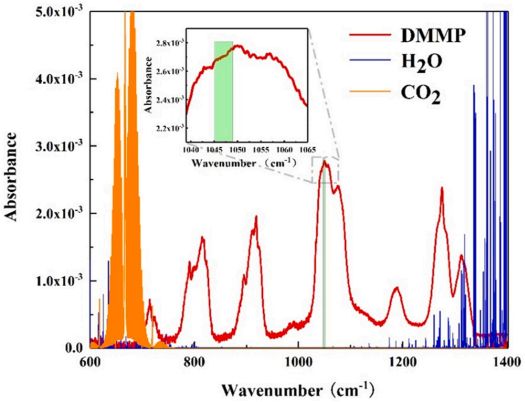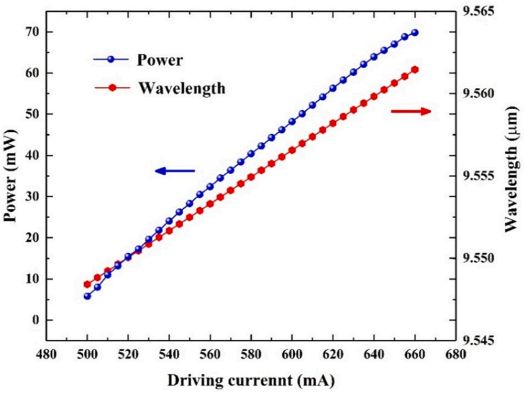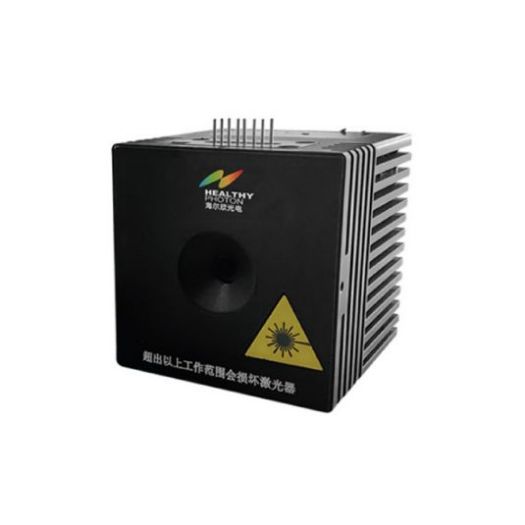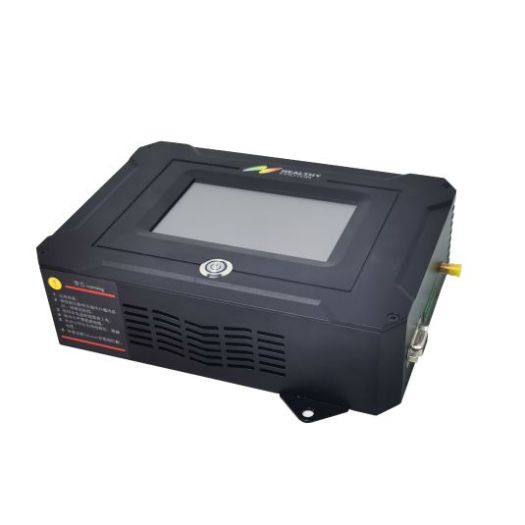近日,来自山西大学激光光谱研究所、光学协同创新中心,-巴里大学和巴里理工大学跨校物理系波利森斯实验室的联合研究团队发表了《Ppb级中红外石英增强光声传感器,用于使用T型音叉调谐探测DMMP》论文。
Recently, the joint research team from State Key Laboratory of Quantum Optics and Quantum Optics Devices, Institute of Laser Spectroscopy, Shanxi University, Collaborative Innovation Center of Extreme Optics, PolySense Lab-Dipartimento Interateneo di Fisica, University and Politecnico of Bari published an academic papers Ppb-level mid-IR quartz-enhanced photoacoustic sensor for DMMP detection using a T-shaped tuning fork.
二甲基甲基膦酸酯(DMMP)被广泛认为是最具代表性的模拟物,已开发并广泛用于DMMP检测的各种气体分析技术。
气相色谱(GC)和质谱(MS)分析可以高敏感地鉴定不同的有机磷化合物,但它们在原位监测方面具有几个缺点,包括昂贵和耗时。此外,色谱分析必须由熟练的人员在专门的实验室中进行,不适合小型化。相比,光声光谱(PAS)是DMMP气体水平监测最有前景的技术之一,因为它具有高灵敏度、选择性和快速响应的优势。作为PAS的一种变体,石英增强光声光谱(QEPAS)技术自2002年首次报道以来迅速发展,其中超窄带石英调谐叉(QTF)与两个作为锐利共振声学换能器的声学微共振器(AmRs)在声学上耦合,用于检测声音信号,而不是传统的宽带麦克风。与体积超过10 cm3的传统光声池相比,小体积的QTF更有利于DMMP检测设备的小型化和快速响应。此外,QEPAS技术的显著特点是激发波长的独立性,这意味着可以使用相同的光谱声学器测量具有不同特征吸收光谱的痕量气体。DMMP在9–11.5 µm的中红外区域显示出强烈的光吸收特征,因此使用高性能中红外量子级联激光器(QCLs)可以在理论上实现高灵敏度的检测。然而,中红外QCL输出光束通常具有较大的发散角,这使得将中红外激光束耦合到具有300微米叉间距的QTF中成为巨大的挑战,因为任何误散射光束击中QTF都会产生大的背景信号。
在本研究中,我们展示了一种基于定制T型QTF和中红外量子级联激光器(QCL)的小型化集成QEPAS DMMP传感器。T型QTF的叉间距为0.8毫米,具有约15,000的高品质因数,避免了由误散射光引起的背景信号,从而在ppb水平上获得最佳检测限。通过使用掺入DMMP的真实室外空气对传感器进行测试,以验证其有效性。
Dimethyl methylphosphonate (DMMP) is widely regarded as the most representative simulant and has been developed and extensively utilized in various gas analysis techniques for DMMP detection.
Gas chromatography (GC) and mass spectrometry (MS) analysis can identify the different organophosphorus compounds with high sensitivity, but they have several disadvantages for in situ monitoring, including being expensive and time-consuming. Moreover, the chromatographic analysis must be performed in a specialized laboratory by skilled personnel and is not suitable for miniaturization. Compared with the above techniques, photoacoustic spectroscopy (PAS) is one of the most promising techniques for sarin gas level monitoring in public places due to its benefits of high sensitivity, selectivity, and fast response. The quartz-enhanced photoacoustic spectroscopy (QEPAS) technique as a variant of PAS has rapidly developed since it was first reported in 2002, in which an ultra-narrowband quartz tuning fork (QTF) acoustically couples with two acoustic micro-resonators (AmRs) acting as a sharply resonant acoustic transducer to detect sound signals instead of conventional broadband microphones. Compared with the sizes of the conventional photoacoustic cell, which is more than 10 cm3, the small volume of QTF is more conducive to the miniaturization and rapid response of sarin or DMMP detection equipment. Besides, the remarkable feature of the QEPAS technique is the excitation wavelength independence, meaning that trace gases with different characteristic absorption spectra can be measured using the same spectrophone. Sarin and DMMP show strong optical absorption features in the mid-infrared region of 9–11.5 µm, so high detection sensitivity can be theoretically achieved using high-performance mid-infrared quantum cascade lasers (QCLs). However, the mid-infrared QCL output beam usually has a large divergence angle, which makes it a great challenge to couple a mid-infrared laser beam through a 300-μm prong-spacing QTF since any stray light hitting the QTF can cause a large background signal.
In this work, we demonstrate a miniaturized and integrated QEPASbased DMMP sensor, in which a custom T-shaped QTF and a midinfrared quantum cascade laser (QCL) are used. The T-shaped QTF has a prong spacing of 0.8 mm and a high-quality factor of ~ 15,000, avoiding the background signal caused by stray light, thus obtaining an optimal detection limit at the ppb level. The DMMP sensor was tested using real outdoor air mixed with DMMP to verify its effectiveness.
实验部分:检测波长和光学激发源的选择
强有力的靶向吸收带对于DMMP检测至关重要,因为实际应用需要具有亚百万分之一灵敏度的传感装置。
由于其高输出功率、紧凑性和窄的光谱线宽,QCLs在中红外光谱区域已成为最多功能的半导体激发源。考虑到激发波长和激光源的大小,宁波海尔欣光电科技有限公司为该实验提供了一个发射波长为9.5 µm,线宽为2 MHz的QCL激光器(QC-Qube 200831-AC712)作为DMMP-QEPAS传感器的激发源,其输出功率稳定性<2%,一个具有极低电流噪声和温漂的QCL激光器驱动电路(QC750-Touch™),在室温下操作,以稳定发射波长。通过激光驱动电路将QCL的温度设定为25.5℃。如图2所示,所使用的QCL激光器的输出波长是驱动电流的函数,并且其波长调谐范围落在所选吸收带中(图1中的绿色框区域)。图2中绘制了QCL激光器的平均功率与驱动电流之间的线性关系,表现出良好的线性关系。此外,该激光源的小尺寸是一个显著特点,外部尺寸约为300 cm3(65 × 65 × 70 mm3),使激光源能够实现紧凑的气体传感器。
Experimental section: Selection of detection wavelength and optical excitation source
A strong targeted absorption band is vital for DMMP detection because the practical application necessitates sensing devices with subparts-per-million sensitivities. Considering the excitation wavelength and size of the laser source, a QCL laser (Ningbo Healthy Photon Technology, QC-Qube 200831- AC712) with an emission wavelength of 9.5 µm and a linewidth of 2 MHz was employed as the excitation source of the DMMP-QEPAS sensor, which has an output power stability of < 2 %. The QCL laser driving circuit (Healthy Photon QC750-Touch™) with extremely low current noise and temperature drift operated at room temperature for stabilizing the emitting wavelength. The temperature of the QCL was set to 25.5 ℃ by means of the laser driving circuit. As shown in Fig. 2, the output wavelength of the QCL laser used is a function of the driving current and its wavelength tuning range fall in the selected absorption band (the green box area in Fig. 1). The linear relationship between the average power of the QCL laser and the driving current was plotted in Fig. 2, demonstrating good linearity. Moreover, the small size is a noticeable feature of this laser source, which has an outside dimension of ~ 300 cm3 (65 × 65 × 70 mm3), allowing the laser source to realize compact gas sensors.

Fig. 1. Absorption spectra of 1-ppm DMMP/N2 gas mixture (red) obtained by the FTIR spectrometer and absorption spectra of 300-ppm H2O (blue) and 5- ppm CO2 (orange) based on HITRAN database. Inset: DMMP absorption band in the range of 1040–1065 cm− 1 and wavelength tuning range of the used QCL laser.

Fig. 2. QCL emission wavelength and output optical power as a function of driving current in amplitude modulation operating mode with a duty cycle of 50 %.


QCL laser: HealthyPhoton, QC-Qube QCL laser driving circuit:: Healthy Photon, QC750-Touch™
结论
基于QEPAS的传感器由于其波长独立性具有很高的多功能性,这使得通过替换激光源可以检测各种神经毒剂。在本研究中,首次开发了一种紧凑尺寸和可靠性能的ppb级QEPAS DMMP传感器。选择了9.56 µm的激发波长,这是最强的DMMP吸收带,不受H2O和CO2的干扰。优化了主要系统参数,包括激光激发功率、气体压力和调制频率。最终,在0至1.5 ppm范围内验证了传感器的线性,并在300毫秒的积分时间下实现了6 ppb的最低检测限。我们使用真实室外空气作为载气检测了500 ppb的DMMP,并获得了与以零气作为载气时相同的信号幅度,从而验证了传感器的高选择性。
Conclusions
The QEPAS-based sensor has high versatility due to its wavelength independence, which makes it possible to detect various nerve agents by replacing the laser sources. In this work, a ppb-level QEPAS-based DMMP sensor was developed with a compact size and reliable performance for the first time. An excitation wavelength of 9.56 µm was chosen for the strongest DMMP band which is interference-free from H2O and CO2. The main system parameters, including the laser excitation power, the gas pressure, and the modulation frequency, were optimized. Finally, the sensor linearity was verified in the range of 0 − 1.5 ppm and a minimum detection limit of 6 ppb at an integration time of 300 ms was achieved. We detected 500 ppb DMMP with real outdoor air as the carrier gas and obtained the same signal amplitude as
that with zero air as the carrier gas, which verified the high selectivity of the sensor.
参考
Ppb-level mid-IR quartz-enhanced photoacoustic sensor for sarin simulant detection using a T-shaped tuning fork, Sensors & Actuators: B. Chemical 390 (2023) 133937, https://doi.org/10.1016/j.snb.2023.133937